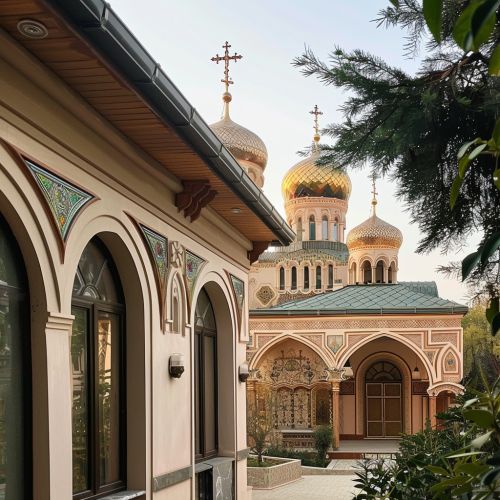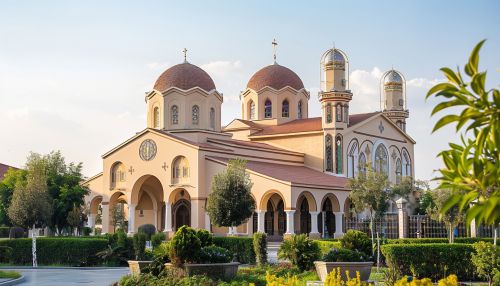Eastern Catholic Churches: Difference between revisions
(Created page with "==Introduction== Eastern Catholic Churches are autonomous, self-governing particular churches in full communion with the Pope. They follow the Eastern Christian traditions in their liturgy, theology, spirituality, and canon law, but are in communion with the universal Catholic Church headed by the Bishop of Rome. The term "Eastern Catholic" should not be confused with "Eastern Orthodox" which refers to churches that are in communion with the Patriarchate of Constantino...") |
No edit summary |
||
| (One intermediate revision by the same user not shown) | |||
| Line 2: | Line 2: | ||
Eastern Catholic Churches are autonomous, self-governing particular churches in full communion with the Pope. They follow the Eastern Christian traditions in their liturgy, theology, spirituality, and canon law, but are in communion with the universal Catholic Church headed by the Bishop of Rome. The term "Eastern Catholic" should not be confused with "Eastern Orthodox" which refers to churches that are in communion with the [[Patriarchate of Constantinople|Ecumenical Patriarch of Constantinople]], but not with the Pope. | Eastern Catholic Churches are autonomous, self-governing particular churches in full communion with the Pope. They follow the Eastern Christian traditions in their liturgy, theology, spirituality, and canon law, but are in communion with the universal Catholic Church headed by the Bishop of Rome. The term "Eastern Catholic" should not be confused with "Eastern Orthodox" which refers to churches that are in communion with the [[Patriarchate of Constantinople|Ecumenical Patriarch of Constantinople]], but not with the Pope. | ||
[[Image:Detail-77691.jpg|thumb|center|A view of an Eastern Catholic Church with its distinctive architecture. The church should be in a serene setting, showcasing its unique design elements such as domes and ornate decorations.|class=only_on_mobile]] | |||
[[Image:Detail-77692.jpg|thumb|center|A view of an Eastern Catholic Church with its distinctive architecture. The church should be in a serene setting, showcasing its unique design elements such as domes and ornate decorations.|class=only_on_desktop]] | |||
==History== | ==History== | ||
Latest revision as of 03:41, 7 May 2024
Introduction
Eastern Catholic Churches are autonomous, self-governing particular churches in full communion with the Pope. They follow the Eastern Christian traditions in their liturgy, theology, spirituality, and canon law, but are in communion with the universal Catholic Church headed by the Bishop of Rome. The term "Eastern Catholic" should not be confused with "Eastern Orthodox" which refers to churches that are in communion with the Ecumenical Patriarch of Constantinople, but not with the Pope.


History
The history of the Eastern Catholic Churches is characterized by the struggles and the efforts they have undergone to maintain their unique identities. This history can be divided into three major periods: the early period, the middle period, and the modern period.
Early Period
The early period of the Eastern Catholic Churches' history begins with the Great Schism of 1054, which marked the formal division of the Christian Church into Eastern (Greek) and Western (Latin) branches. This division was primarily over issues of ecclesiastical authority and theological differences, particularly the filioque clause.
Middle Period
The middle period is marked by the attempts of the Catholic Church to reunite with the Eastern Churches. This was primarily through the Union of Brest in 1596 and the Union of Uzhhorod in 1646. These unions resulted in the creation of the Ukrainian Greek Catholic Church and the Ruthenian Greek Catholic Church, respectively.
Modern Period
The modern period began in the late 18th century and continues to the present day. This period is characterized by a series of reforms within the Eastern Catholic Churches, and a growing recognition and respect for their Eastern Christian heritage within the Catholic Church.
Theology
Eastern Catholic theology, while fully in line with the teachings of the Catholic Church, often demonstrates a different emphasis than that typically found in the Latin Church. This is not a matter of contradiction, but of complementarity. Eastern Catholic theology is rooted in the early Church Fathers and is heavily influenced by the spiritual traditions of the East.
Christology
Eastern Catholic Churches share the same Christological doctrine as the Catholic Church, affirming the teaching of the Council of Chalcedon in 451 AD that Christ is one person in two natures, divine and human.
Trinitarian Theology
Eastern Catholic Churches emphasize the monarchy of God the Father within the Holy Trinity. This is reflected in their liturgical life, particularly in the Eucharistic prayer.
Sacraments
Eastern Catholic Churches recognize the same seven sacraments as the Latin Church: Baptism, Confirmation (Chrismation), Eucharist, Penance, Anointing of the Sick, Holy Orders, and Matrimony.
Liturgy
The liturgical life of the Eastern Catholic Churches is rich and varied. While they all celebrate the same sacraments, the liturgical traditions vary greatly from church to church.
Divine Liturgy
The Divine Liturgy is the center of worship in the Eastern Catholic Churches. The two primary forms of the Divine Liturgy are the Liturgy of St. John Chrysostom and the Liturgy of St. Basil the Great.
Liturgical Year
The liturgical year in the Eastern Catholic Churches begins on September 1 and includes a cycle of fasts and feasts that commemorate the life of Christ, the Theotokos (Mary), and the saints.
Churches
There are 23 Eastern Catholic Churches, each with its own unique liturgical, theological, spiritual and canonical heritage. These include the Maronite Church, Melkite Greek Catholic Church, Ukrainian Greek Catholic Church, Ruthenian Catholic Church, and others.
Conclusion
The Eastern Catholic Churches, while fully part of the Catholic Church, maintain their own unique identities and traditions. They continue to enrich the universal Church with their distinctive liturgical practices, theological insights, and spiritual traditions.
